Fuzzy Algorithms for Diagnosis of Furnace Transformer Insulation Condition
Abstract
:1. Introduction
1.1. Development of Online Monitoring Systems
- hardware and software development;
- validation of mathematical analysis methods and selection of diagnostic parameters and condition categories.
1.2. Validation of Condition Analysis Methods Fuzzy Logic
1.3. Selection of Diagnostic Parameters—Partial Discharge Monitoring
- PD power, usually reduced to PDI−Partial Discharge Intensity. This parameter is defined as the total energy of discharges divided by the time of their summation, which is why it has the same dimensionality as power [maw]. The parameter describes the power and intensity of PD and is determined by the dependency [48,49].
1.4. Generalized Transformer Condition Indicators
2. Problem Statement
2.1. Monitoring System Description
2.2. Experimental PD Analysis
3. Materials and Methods
- normal condition (1) if or ;
- poor condition (2) if or ;
- critical condition (3) if or .
- near-critical condition (2’) if or ;
- emergency condition (3’) if or .
4. Implementation
4.1. Example of Generalized Indicator-Based Transformer Condition Assessment
4.2. PD Readings Sensitivity Testing
- For quantification, it is proposed to use a generalized indicator descriptive of the hazard of PD for insulation. In this case, such an indicator has to be a normalized characteristic of the informative parameters with respect to the difference between the poor/critical condition threshold () and normal (background) readings.Normalized values () ensure that the requirements of dimensionlessness and 0–1 rating scale uniformity are met at .
- Since PD activity is measured by reading the voltage U02 and the power PDI, they correspond to two normalized indicators: XU and XP. For the parameter of their co-effect, we suggest the geometric mean hereinafter referred to as PD Activity Level.Given the expressions (5) and (6)where P0 and U0 are the initial PDI and U02, PjD, UjD are the thresholds for poor condition (j = 1) and critical condition (j = 2).
- Calculate the mean of each signal over the specified timeframeor the Euclidean normwhere N is the number of points for the specified timeframe.These parameters need to be introduced because Pi and Ui are random values that can deviate substantially from the means. In order to prevent random scatter, assume values averaged over a small interval, which are calculated by the dependencies (8) or (9).
- To find out which of the parameters (PDI or U02) is more sensitive to insulation condition, we hereby suggest considering how the difference in their normalized values changes over time:
5. Results and Discussion
- Over the time when the transformer was in a normal condition (from the initial readings to ~10 October), PD activity level (Figure 9a) did not change significantly for any phase. Therefore, neither reading (PDI or U02) could be considered conclusive.
- A further positive increase in ΔX signified a substantial increase in the effect of PDI on discharge activity. Therefore, from ~10 October until mid-December, i.e., when the condition was poor, PDI would be the more informative parameter.
- Once the transformer’s condition became critical (after ~18 October), the discharge activity index LPD (Figure 9a) went up in all phases. That being said, an increased PD intensity was reported by the sensors installed at the PIN terminals of three high-voltage bushings.
- After ~18 October, in light of the looming emergency, it became again difficult to choose the preferable diagnostic parameter: Figure 9b shows a positive change in ΔX in Phase C and a negative change in Phases A and B.
- In poor condition, the greatest increase in discharge activity was observed in Phase C, whereas the activity in Phases A and B was not significant, see Figure 9a. It would be therefore logical to assume that the critical condition was caused by an expanding defect in Phase C, see proof below.
6. Conclusions and Future Work
- −
- Calculating the standardized indicator to satisfy the requirements for the grade scale zero-dimensionality and uniformity.
- −
- Determining the geometric average PD activity level;
- −
- Calculating the average value for each of the signals within the set interval (or Euclidean norm);
- −
- Determining the sensitivity of the PDI and U02 to the insulation state in terms of the size and sign of the standardized indicator.
Author Contributions
Funding
Institutional Review Board Statement
Data Availability Statement
Conflicts of Interest
References
- Guide on Transformer Intelligent Condition Monitoring (TICM) Systems. Available online: https://pureportal.strath.ac.uk/en/publications/guide-on-transformer-intelligent-condition-monitoring-ticm-system (accessed on 24 March 2022).
- Bohatyrewicz, P.; Mrozik, A. The Analysis of Power Transformer Population Working in Different Operating Conditions with the Use of Health Index. Energies 2021, 14, 5213. [Google Scholar] [CrossRef]
- Naderian, A.; Cress, S.; Piercy, R.; Wang, F.; Service, J. An approach to determine the health index of power transformers. In Proceedings of the Conference Record of the IEEE International Symposium on Electrical Insulation, Vancouver, BC, Canada, 9–12 June 2008; pp. 192–196. [Google Scholar] [CrossRef]
- Kittan, S.; Kornhuber, S.; Kastel, P.; Nitsche, G.; Valtin, G.; Weise, M. Review and implementation of transformer health index methods in line with the development of a condition assessment tool. In Proceedings of the International Conference on Diagnostics in Electrical Engineering Diagnostika, Pilsen, Czech Republic, 4–7 September 2018; pp. 1–4. [Google Scholar] [CrossRef]
- Arshad, M.; Islam, S.; Khaliq, A. Fuzzy logic approach in power transformers management and decision making. Dielectr. Electr. Insul. IEEE Trans. 2014, 21, 2343–2354. [Google Scholar] [CrossRef]
- Khramshin, V.R.; Evdokimov, S.A.; Nikolaev, A.A.; Nikolaev, A.A.; Karandaev, A.S. Monitoring technical state of the power transformers is a necessary condition of the smart-grid technology introduction within the industrial electric networks. In Proceedings of the IEEE NW Russia Young Researchers in Electrical and Electronic Engineering Conference (EIConRusNW), St. Petersburg, Russia, 2–4 February 2015; pp. 214–220. [Google Scholar] [CrossRef]
- Singh, J.; Aggarwal, S. Distribution transformer monitoring for smart grid in India. In Proceedings of the IEEE 1st International Conference on Power Electronics, Intelligent Control and Energy Systems (ICPEICES), Delhi, India, 4–6 July 2016; pp. 1–6. [Google Scholar] [CrossRef]
- Tran, Q.T.; Davies, K.; Roose, L.; Wiriyakitikun, P.; Janjampop, J.; Riva Sanseverino, E.; Zizzo, G. A Review of Health Assessment Techniques for Distribution Transformers in Smart Distribution Grids. Appl. Sci. 2020, 10, 8115. [Google Scholar] [CrossRef]
- Thangiah, L.; Ramanathan, C.; Chodisetty, L.S. Distribution transformer condition monitoring based on edge intelligence for industrial IoT. In Proceedings of the IEEE 5th World Forum on Internet of Things (WF-IoT), Limerick, Ireland, 15–18 April 2019; pp. 733–736. [Google Scholar] [CrossRef]
- Izidoro, C.L.; Rocha, A.O.; Spacek, J.D.; Neto, J.M.; Spacek, A.D.; Ando Junior, O.H. Development of an Industrial IoT Based Monitoring System for Voltage Regulators. IEEE Lat. Am. Trans. 2021, 19, 1410–1416. [Google Scholar] [CrossRef]
- Nicolaou, C.; Mansour, A.; Jung, P.; Schellenberg, M.; Würde, A.; Walukiewicz, A.; Kahlen, J.N.; Shekow, M.; Laerhoven, K.V. Intelligent, sensor-based condition monitoring of transformer stations in the distribution network. In Proceedings of the Smart Systems Integration (SSI), Grenoble, France, 27–29 April 2021; pp. 1–4. [Google Scholar] [CrossRef]
- Rediansyah, D.; Prasojo, R.A.; Suwarno; Abu-Siada, A. Artificial Intelligence-Based Power Transformer Health Index for Handling Data Uncertainty. IEEE Access 2021, 9, 150637–150648. [Google Scholar] [CrossRef]
- Refaat, S.S.; Abu-Rub, H. Smart grid condition assessment: Concepts, benefits and developments. Power Electron. Drives 2016, 2, 147–163. [Google Scholar] [CrossRef]
- Wang, G.; Liu, Y.; Chen, X.; Yan, Q.; Sui, H.; Ma, C.; Zhang, J. Power transformer fault diagnosis system based on Internet of Things. EURASIP J. Wirel. Commun. Netw. 2021, 2021, 21. [Google Scholar] [CrossRef]
- Chakravorti, S.; Dey, D.; Chatterjee, B. Recent trends in the condition monitoring of transformers. In Power Systems; Springer: London, UK, 2013. [Google Scholar] [CrossRef]
- Khan, M.A.; Zakir, H.Z.; Hasmat, M.H. Recent Trends in Power Transformer Fault Diagnosis and Condition Assessment. Bull. Electr. Eng. Inform. 2013, 2, 95–104. [Google Scholar] [CrossRef]
- Guo, C.; Dong, M.; Yang, X.; Wang, W. A Review of on-line condition monitoring in power system. In Proceedings of the IEEE 8th International Conference on Advanced Power System Automation and Protection (APAP), Xi’an, China, 21–24 October 2019; pp. 634–637. [Google Scholar] [CrossRef]
- Singh, R.P.; Sonawane, A.V.; Satpute, M.S.; Shirsath, D.Y.; Thakre, M. A review on traditional methods of condition monitoring of transformer. In Proceedings of the International Conference on Electronics and Sustainable Communication Systems (ICESC), Coimbatore, India, 2–4 July 2020; pp. 1144–1152. [Google Scholar] [CrossRef]
- Žarković, M.; Stojković, Z. Analysis of artificial intelligence expert systems for power transformer condition monitoring and diagnostics. Electr. Power Syst. Res. 2017, 149, 125–136. [Google Scholar] [CrossRef]
- Chaves, T.R.; Martins, M.A.I.; Martins, K.A.; de Macedo, A.F.; de Francisci, S. Application Study in the Field of Solutions for the Monitoring Distribution Transformers of the Overhead Power Grid. Energies 2021, 14, 6072. [Google Scholar] [CrossRef]
- Tenbohlen, S.; Coenen, S.; Djamali, M.; Müller, A.; Samimi, M.H.; Siegel, M. Diagnostic Measurements for Power Transformers. Energies 2016, 9, 347. [Google Scholar] [CrossRef]
- Karandaev, A.S.; Evdokimov, S.A.; Sarlibaev, A.A.; Lednov, R.A. Requirements to the Monitoring System of Ultra-High Power Electric Arc Furnace Transformer Performance. Russ. Internet J. Ind. Eng. 2013, 2, 58–68. [Google Scholar]
- Lozynskyy, A.; Kozyra, J.; Łukasik, Z.; Kuśmińska-Fijałkowska, A.; Kutsyk, A.; Paranchuk, Y.; Kasha, L. A Mathematical Model of Electrical Arc Furnaces for Analysis of Electrical Mode Parameters and Synthesis of Controlling Influences. Energies 2022, 15, 1623. [Google Scholar] [CrossRef]
- Evdokimov, S.A. Technical state monitoring of transformer OLTC of ultrahigh power electric arc furnace. Bull. South-Ural State Univ. Power Eng. 2014, 14, 22–30. [Google Scholar]
- Karandaev, A.S.; Evdokimov, S.A.; Khramshin, V.R.; Lednov, R.A. Diagnostic Functions of a System for Continuous Monitoring of the Technical Condition of the Transformers of Arc Steelmaking Furnaces. Metallurgist 2014, 58, 655–663. [Google Scholar] [CrossRef]
- Karandaev, A.S.; Evdokimov, S.A.; Khramshin, V.R.; Sarlybaev, A.A. System for Real-Time Monitoring of the Technical State of a Transformer on an Ultrahigh-Power Electric-Arc Steelmaking Furnace. Metallurgist 2014, 58, 872–879. [Google Scholar] [CrossRef]
- Fernández, J.C.; Corrales, L.B.; Hernández, F.H.; Benítez, I.F.; Núñez, J.R. A fuzzy logic proposal for diagnosis multiple incipient faults in a power transformer. In Progress in Artificial Intelligence and Pattern Recognition; Lecture Notes in Computer Science, 13055; Springer: Cham, Switzerland, 2021; pp. 187–198. [Google Scholar] [CrossRef]
- Apte, S.; Somalwar, R.; Wajirabadkar, A. Incipient fault diagnosis of transformer by DGA using fuzzy logic. In Proceedings of the IEEE International Conference on Power Electronics, Drives and Energy Systems (PEDES), Chennai, India, 18–21 December 2018; pp. 1–5. [Google Scholar] [CrossRef]
- Ahmed, M.R.; Geliel, M.A.; Khalil, A. Power transformer fault diagnosis using fuzzy logic technique based on dissolved gas analysis. In Proceedings of the 21st Mediterranean Conference on Control and Automation, Platanias, Greece, 25–28 June 2013; pp. 584–589. [Google Scholar] [CrossRef]
- Mharakurwa, E.T.; Nyakoe, G.N.; Akumu, A.O. Power Transformer Fault Severity Estimation Based on Dissolved Gas Analysis and Energy of Fault Formation Technique. J. Electr. Comput. Eng. 2019, 2019, 9674054. [Google Scholar] [CrossRef] [Green Version]
- Taha, I.B.M.; Ibrahim, S.; Mansour, D.-E.A. Power Transformer Fault Diagnosis Based on DGA Using a Convolutional Neural Network with Noise in Measurements. IEEE Access 2021, 9, 111162–111170. [Google Scholar] [CrossRef]
- Ranga, C.; Chandel, A.K.; Chandel, R. Expert system for condition monitoring of power transformer using fuzzy logic. J. Renew. Sustain. Energy 2017, 9, 044901. [Google Scholar] [CrossRef]
- Aghaei, J.; Gholami, A.; Shayanfar, H.A.; Dezhamkhooy, A. Dissolved gas analysis of transformers using fuzzy logic approach. Eur. Trans. Electr. Power 2009, 20, 630–638. [Google Scholar] [CrossRef]
- Poonnoy, N.; Suwanasri, C.; Suwanasri, T. Fuzzy Logic Logic Approach to Dissolved Gas Analysis for Power Transformer Failure Index and Fault Identification. Energies 2021, 14, 36. [Google Scholar] [CrossRef]
- Su, C.Q. A new fuzzy logic method for transformer incipient fault diagnosis. In Proceedings of the IEEE International Conference on Fuzzy Systems (FUZZ-IEEE), Vancouver, BC, Canada, 24–29 July 2016; pp. 324–327. [Google Scholar] [CrossRef]
- Malik, H.; Tarkeshwar; Jarial, R.K. An expert system for incipient fault diagnosis and condition assessment in transformers. In Proceedings of the International Conference on Computational Intelligence and Communication Networks, Gwalior, India, 7–9 October 2011; pp. 138–142. [CrossRef]
- Abu-Siada, A.; Hmood, S.; Islam, S. A new fuzzy logic approach for consistent interpretation of dissolved gas-in-oil analysis. IEEE Trans. Dielectr. Electr. Insul. 2013, 2, 2343–2349. [Google Scholar] [CrossRef] [Green Version]
- Alqudsi, A.; El-Hag, A. Application of Machine Learning in Transformer Health Index Prediction. Energies 2019, 12, 2694. [Google Scholar] [CrossRef] [Green Version]
- Husain, Z. Fuzzy Logic Expert System for Incipient Fault Diagnosis of Power Transformers. Int. J. Electr. Eng. Inform. 2018, 10, 300–317. [Google Scholar] [CrossRef]
- Genc, S.; Karagol, S. Fuzzy logic application in DGA methods to classify fault type in power transformer. In Proceedings of the International Congress on Human-Computer Interaction, Optimization and Robotic Applications (HORA), Ankara, Turkey, 26–28 June 2020; pp. 1–4. [Google Scholar] [CrossRef]
- Luo, Y.; Li, Z.; Wang, H. A Review of Online Partial Discharge Measurement of Large Generators. Energies 2017, 10, 1694. [Google Scholar] [CrossRef] [Green Version]
- Muhr, M.; Schwarz, R. Partial discharge measurement as a diagnostic tool for HV-equipments. In Proceedings of the IEEE 8th International Conference on Properties and Applications of Dielectric Materials, Bali, Indonesia, 26–30 June 2006. [Google Scholar] [CrossRef]
- Baker, P.C.; Stephen, B.; Judd, M.D. Compositional Modeling of Partial Discharge Pulse Spectral Characteristics. IEEE Trans. Instrum. Meas. 2013, 62, 1909–1916. [Google Scholar] [CrossRef] [Green Version]
- Commission, I.E. IEC 60270: High-Voltage Test Techniques-Partial Discharge Measurements. Available online: https://webstore.iec.ch/publication/1247 (accessed on 24 March 2022).
- Gianoglio, C.; Ragusa, E.; Gastaldo, P.; Gallesi, F.; Guastavino, F. Online Predictive Maintenance Monitoring Adopting Convolutional Neural Networks. Energies 2021, 14, 4711. [Google Scholar] [CrossRef]
- Lumba, L.A.; Khayam, U.; Lumba, L.S. Application of fuzzy logic for partial discharge pattern recognition. In Proceedings of the International Conference on Electrical Engineering and Informatics (ICEEI), Bandung, Indonesia, 9–10 July 2019; pp. 210–215. [Google Scholar] [CrossRef]
- Seifi, S.; Werle, P.; Shayegani Akmal, A.A.; Mohseni, H.; Borsi, H. A feasibility study on estimating induced charge of partial discharges in transformer windings adjacent to its origin. Int. J. Electr. Power Energy Syst. 2021, 129, 106899. [Google Scholar] [CrossRef]
- Rusov, V.A. Measurement of Partial Discharges in Insulation of High-Voltage Equipment; UrGUPS: Yekaterinburg, Russia, 2011; 367p. [Google Scholar]
- Karandaeva, O.I.; Yakimov, I.A.; Filimonova, A.A.; Gartlib, E.A.; Yachikov, I.M. Stating Diagnosis of Current State of Electric Furnace Transformer on the Basis of Analysis of Partial Discharges. Machines 2019, 7, 77. [Google Scholar] [CrossRef] [Green Version]
- NPP Maintenance and Repair Guidelines. Concern ROSENERGOATOM. Available online: https://files.stroyinf.ru/Data2/1/4293777/4293777767.pdf (accessed on 24 March 2022).
- Alvarez, F.; Ortego, J.; Garnacho, F.; Sanchez-Uran, M.A. A clustering technique for partial discharge and noise sources identification in power cables by means of waveform parameters. IEEE Trans. Dielectr. Electr. Insul. 2016, 23, 469–481. [Google Scholar] [CrossRef] [Green Version]
- Radionov, A.A.; Evdokimov, S.A.; Sarlybaev, A.A.; Karandaeva, O.I. Application of subtractive clustering for power transformer fault diagnostics. Procedia Eng. 2015, 129, 22–28. [Google Scholar] [CrossRef] [Green Version]
- Teng, W.; Fan, S.; Gong, Z.; Jiang, W.; Gong, M. Fault diagnosis of transformer based on fuzzy clustering and the optimized wavelet neural network. Syst. Sci. Control. Eng. 2018, 6, 359–363. [Google Scholar] [CrossRef] [Green Version]
- Poiss, G. Development of DGA indicator for estimating risk level of power transformers. In Proceedings of the 17th International Scientific Conference on Electric Power Engineering (EPE), Prague, Czech Republic, 16–18 May 2016; pp. 1–4. [Google Scholar] [CrossRef]
- Poiss, G.; Vitolina, S. Development and implementation of risk indicator for power transformers based on electrical measurements. In Proceedings of the 18th International Scientific Conference on Electric Power Engineering (EPE), Kouty nad Desnou, Czech Republic, 17–19 May 2017; pp. 1–4. [Google Scholar] [CrossRef]
- Poišs, G.; Vītoliņa, S.; Mārks, J. Development of Indicators for Technical Condition Indexing of Power Transformers. Adv. Sci. Technol. Eng. Syst. J. 2018, 3, 148–154. [Google Scholar] [CrossRef] [Green Version]
- Kunicki, M.; Cichoń, A.; Nagi, Ł. Statistics based method for partial discharge identification in oil paper insulation systems. Electr. Power Syst. Res. 2018, 163, 559–571. [Google Scholar] [CrossRef]
- Florkowski, M. Influence of Insulating Material Properties on Partial Discharges at DC Voltage. Energies 2020, 13, 4305. [Google Scholar] [CrossRef]
- Behjat, V.; Emadifar, R.; Pourhossein, M.; Rao, U.M.; Fofana, I.; Najjar, R. Improved Monitoring and Diagnosis of Transformer Solid Insulation Using Pertinent Chemical Indicators. Energies 2021, 14, 3977. [Google Scholar] [CrossRef]
- Melnikova, O.; Nazarychev, A.; Suslov, K. Enhancement of the Technique for Calculation and Assessment of the Condition of Major Insulation of Power Transformers. Energies 2022, 15, 1572. [Google Scholar] [CrossRef]
- Nussbaumer, P.; Wolbank, T.M.; Vogelsberger, M.A. Sensitivity analysis of insulation state indicator in dependence of sampling rate and bit resolution to define hardware requirements. In Proceedings of the IEEE International Conference on Industrial Technology (ICIT), Cape Town, South Africa, 25–28 February 2013; pp. 392–397. [Google Scholar] [CrossRef]
- Kelman MINITRANS Cost-Effective On-Line DGA & Moisture for Transformers. Available online: https://www.gegridsolutions.com/products/brochures/md/minitrans.pdf (accessed on 24 March 2022).
- DB-2 Integrated Sensorsf Installation on High-Voltage Bushing Voltage Gauges. Available online: https://dimrus.ru/manuals/db2.pdf (accessed on 24 March 2022).
- Karandaev, A.S.; Evdokimov, S.A.; Khramshin, V.R.; Karandaeva, O.I. Information and measuring system for electric arc furnace transformer monitoring. In Proceedings of the 12th International Conference on Actual Problems of Electronics Instrument Engineering (APEIE), Novosibirsk, Russia, 2–4 October 2014; pp. 273–279. [Google Scholar] [CrossRef]
- Karandaev, A.S.; Khramshin, V.R.; Evdokimov, S.A.; Larina, T.P.; Yachikov, I.M. Practical diagnostics of power transformers with acoustic radar method of partial discharge determination. In Proceedings of the IEEE NW Russia Young Researchers in Electrical and Electronic Engineering Conference (2016 EIConRusNW), St. Petersburg, Russia, 2–3 February 2016; pp. 576–580. [Google Scholar] [CrossRef]
- Radionov, A.A.; Karandaeva, O.I.; Evdokimov, S.A.; Gallyamova, M.S.; Kondrashova, Y.N. Monitoring partial discharges in stationary condition monitoring system of furnace transformer. In Proceedings of the IEEE Conference of Russian Young Researchers in Electrical and Electronic Engineering (EIConRus), St. Petersburg, Russia, 1–3 February 2017; pp. 1571–1575. [Google Scholar] [CrossRef]
- Methodical Directions for to Diagnostic of Mains Transformers, the Autotransformers, Bypassing Chokes and Their Feedings Into MY 0634-2006. Concern ROSENERGOATOM. Available online: http://leg.co.ua/knigi/oborudovanie/diagnostika>-transformatorov-i-shuntiruyuschih-reaktorov.htm (accessed on 24 March 2022).
- Zhao, J.; Gomez-Exposito, A.; Netto, M.; Mili, L.; Abur, A.; Terzija, V.; Kamwa, I.; Pal, B.; Singh, A.K.; Qi, J.; et al. Power System Dynamic State Estimation: Motivations, Definitions, Methodologies and Future Work. IEEE Trans. Power Syst. 2019, 34, 3188–3198. [Google Scholar] [CrossRef]
- Zhao, J.; Netto, M.; Huang, Z.; Yu, S.S.; Gómez-Expósito, A.; Wang, S.; Kamwa, I.; Akhlaghi, S.; Mili, L.; Terzija, V.; et al. Roles of Dynamic State Estimation in Power System Modeling, Monitoring and Operation. IEEE Trans. Power Syst. 2021, 36, 2462–2472. [Google Scholar] [CrossRef]
- Heidari, M. Combined Diagnosis of PD Based on the Multidimensional Parameters. Model. Simul. Eng. 2016, 2016, 5949140. [Google Scholar] [CrossRef]
- Qian, T.; Wei, Q.; Yu, Z.; Tang, W.; Wu, Q. Multi-Parametric Sensitivity Analysis of Improved Transformer Thermal Models Considering Nonlinear Effect of Oil Time Constant. Available online: https://ieeexplore.ieee.org/stamp/stamp.jsp?tp=&arnumber=9215198. (accessed on 24 March 2022).
- Amoda, O.; Tylavsky, D.; McCulla, G.; Knuth, W. Sensitivity of estimated parameters in transformer thermal modeling. In Proceedings of the 41st North American Power Symposium, Starkville, MS, USA, 4–6 October 2009; pp. 1–6. [Google Scholar] [CrossRef]
- Haljasmaa, A.I.; Dmitriyev, S.A.; Kokin, S.Y. Assessment of power transformers based on data analysis technical diagnostics. South Ural State Univ. Bull. Ser. Energy 2013, 13, 114–120. [Google Scholar]
- Karandaev, A.S.; Yachikov, I.M.; Khramshin, V.R. Methods of Multi-Parameter Diagnostics of Electric Equipment Condition within On-line Monitoring Systems. Procedia Eng. 2016, 150, 32–38. [Google Scholar] [CrossRef] [Green Version]
- Fuzzy Logic Toolbox. User’s Guide. The MathWorks, Inc. Available online: https://person.dibris.unige.it/masulli-francesco/lectures/ML-CI/lectures/MATLAB%20fuzzy%20toolbox.pdf (accessed on 24 March 2022).
- Ishibuchi, H.; Nakashima, T.; Murata, T. Performance evaluation of fuzzy classifier systems for multi-dimensional pattern classification problems. IEEE Trans. Syst. Man Cybern. Part B Cybern. 1999, 29, 601–618. [Google Scholar] [CrossRef] [PubMed]
- Mamdani, E.H.; Assilian, S. An Experiment in Linguistic Synthesis with Fuzzy Logic Controller. Int. J. Man-Mach. Stud. 1975, 7, 1–13. [Google Scholar] [CrossRef]
- Thungsuk, N.; Mungkung, N.; Songruk, A.; Tunlasakun, K.; Tikakosol, K.; Nilawat, S.; Boonsomchuae, K.; Yuji, T.; Arunrungrusmi, S.; Kinoshita, H. The Investigation of Detect Position of Partial Discharge in Cast-Resin Transformer Using High-Frequency Current Transformer Sensor and Acoustic Emission Sensor. Appl. Sci. 2022, 12, 1310. [Google Scholar] [CrossRef]
- Wang, Y.; Chang, D.; Fan, Y.; Zhang, G.; Zhan, G.; Shao, X.; He, W. Acoustic localization of partial discharge sources in power transformers using a particle-swarm-optimization-route-searching algorithm. IEEE Trans. Dielectr. Electr. Insul. 2017, 24, 3647–3656. [Google Scholar] [CrossRef]
- Karami, H.; Azadifar, M.; Mostajabi, A.; Rubinstein, M.; Karami, H.; Gharehpetian, G.B.; Rachidi, F. Partial Discharge Localization Using Time Reversal: Application to Power Transformers. Sensors 2020, 20, 1419. [Google Scholar] [CrossRef] [Green Version]

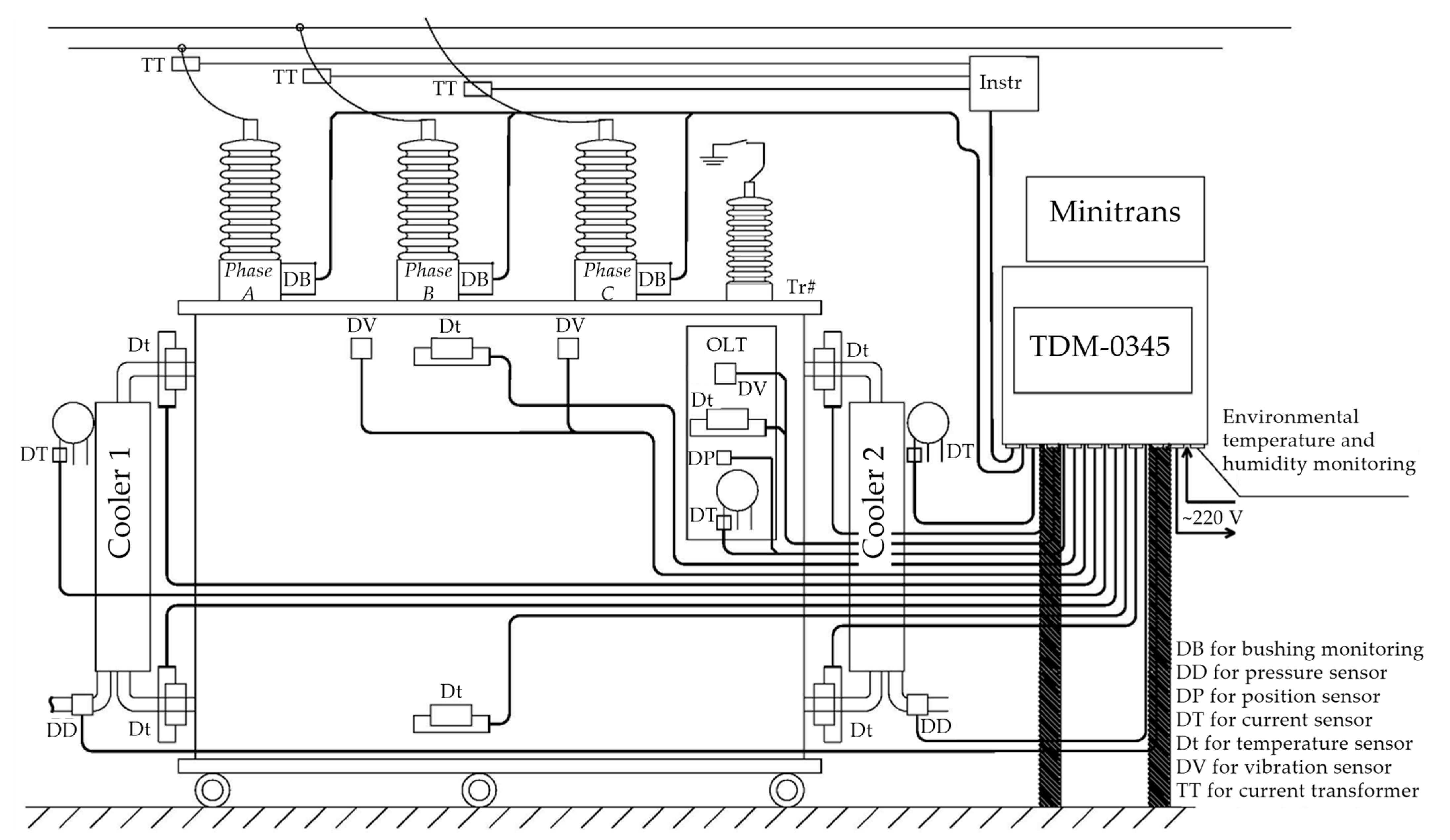

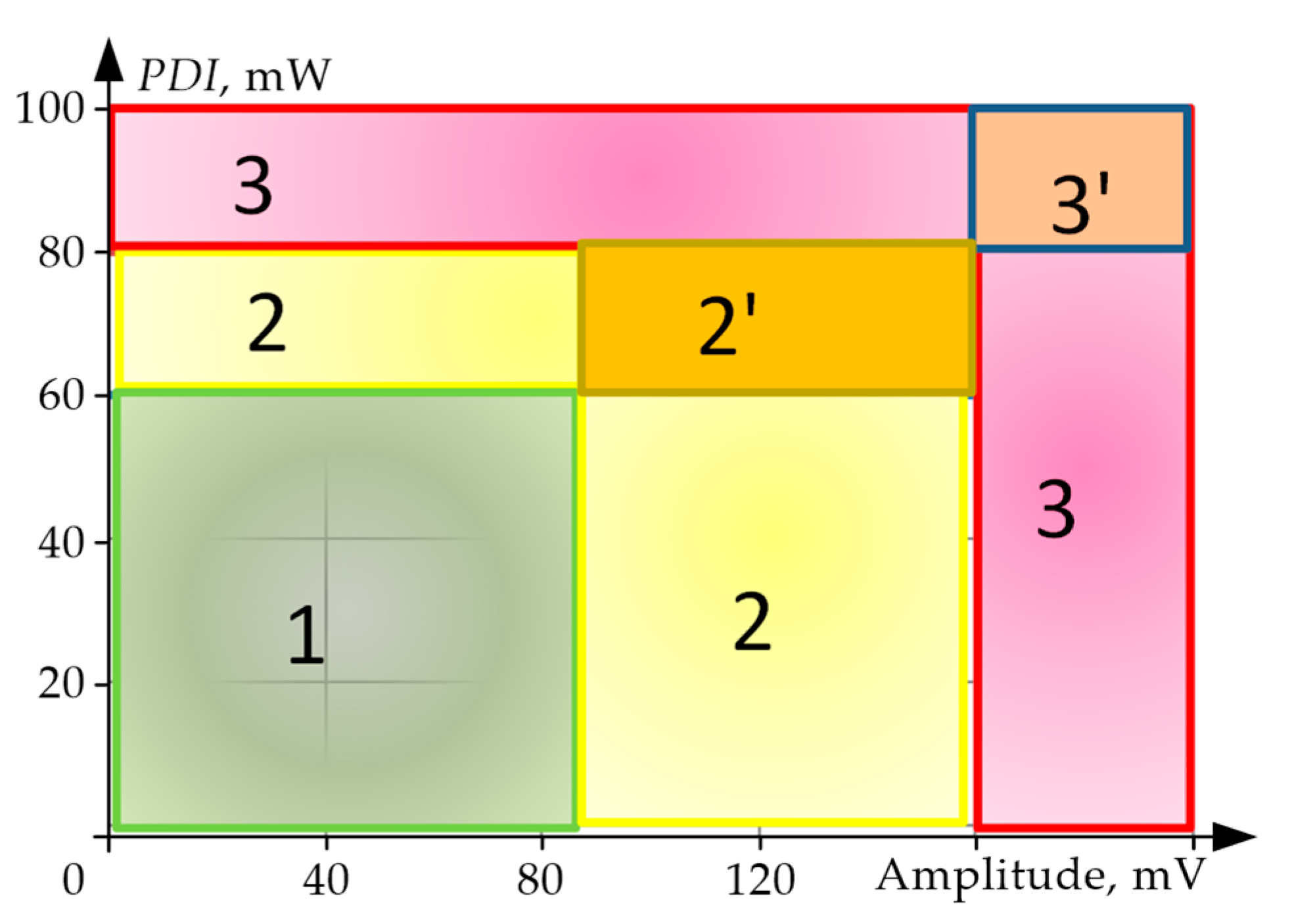
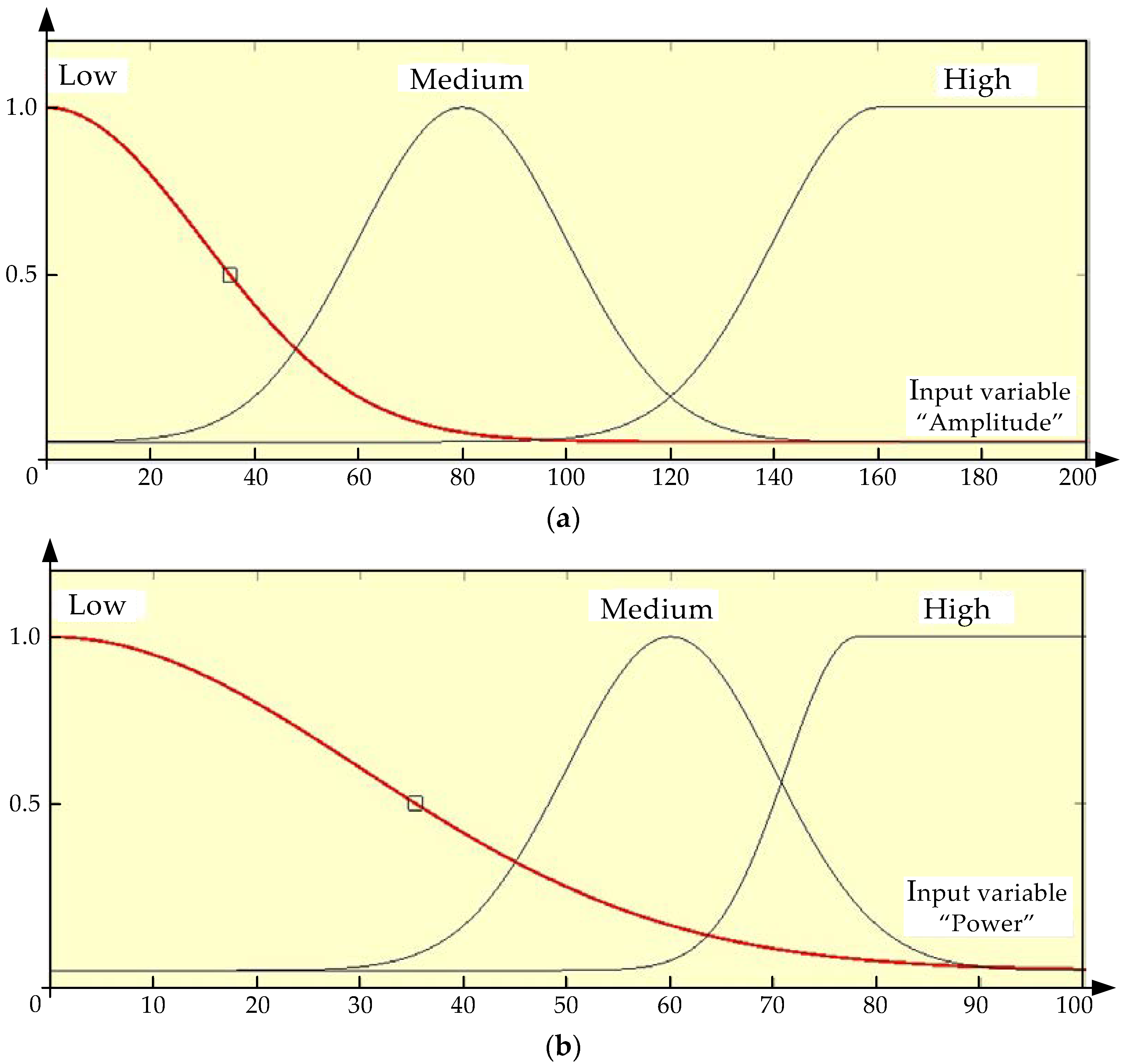
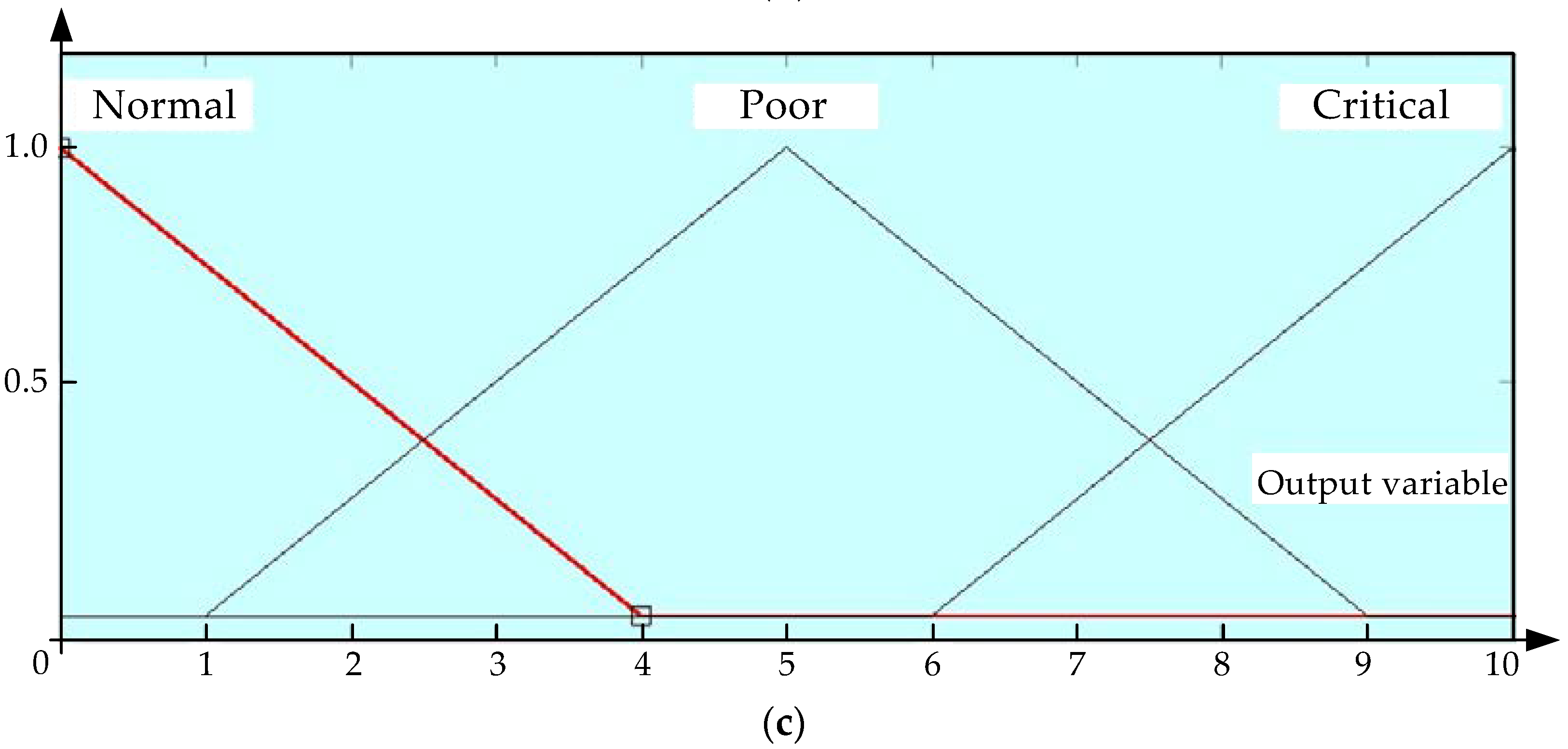
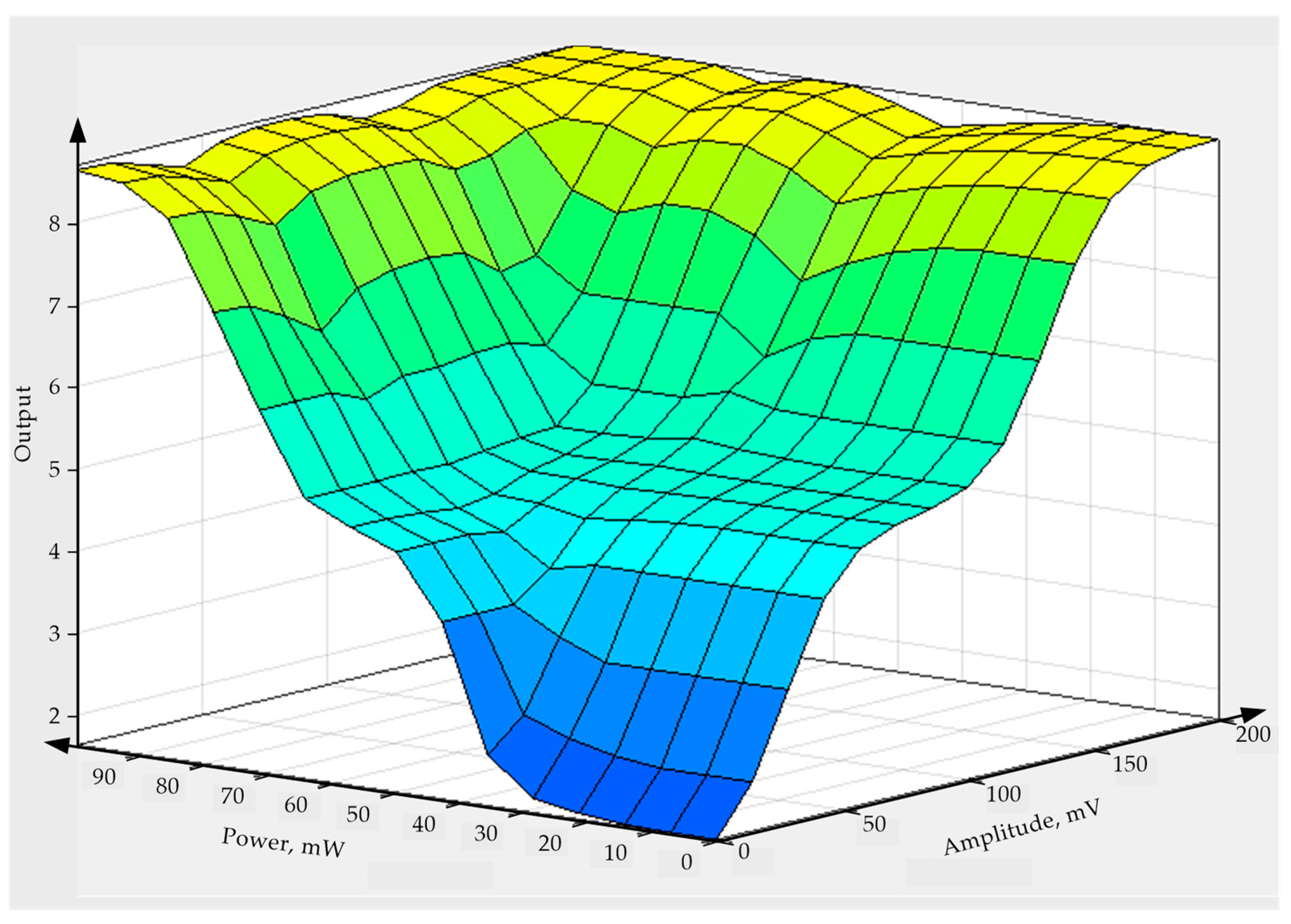
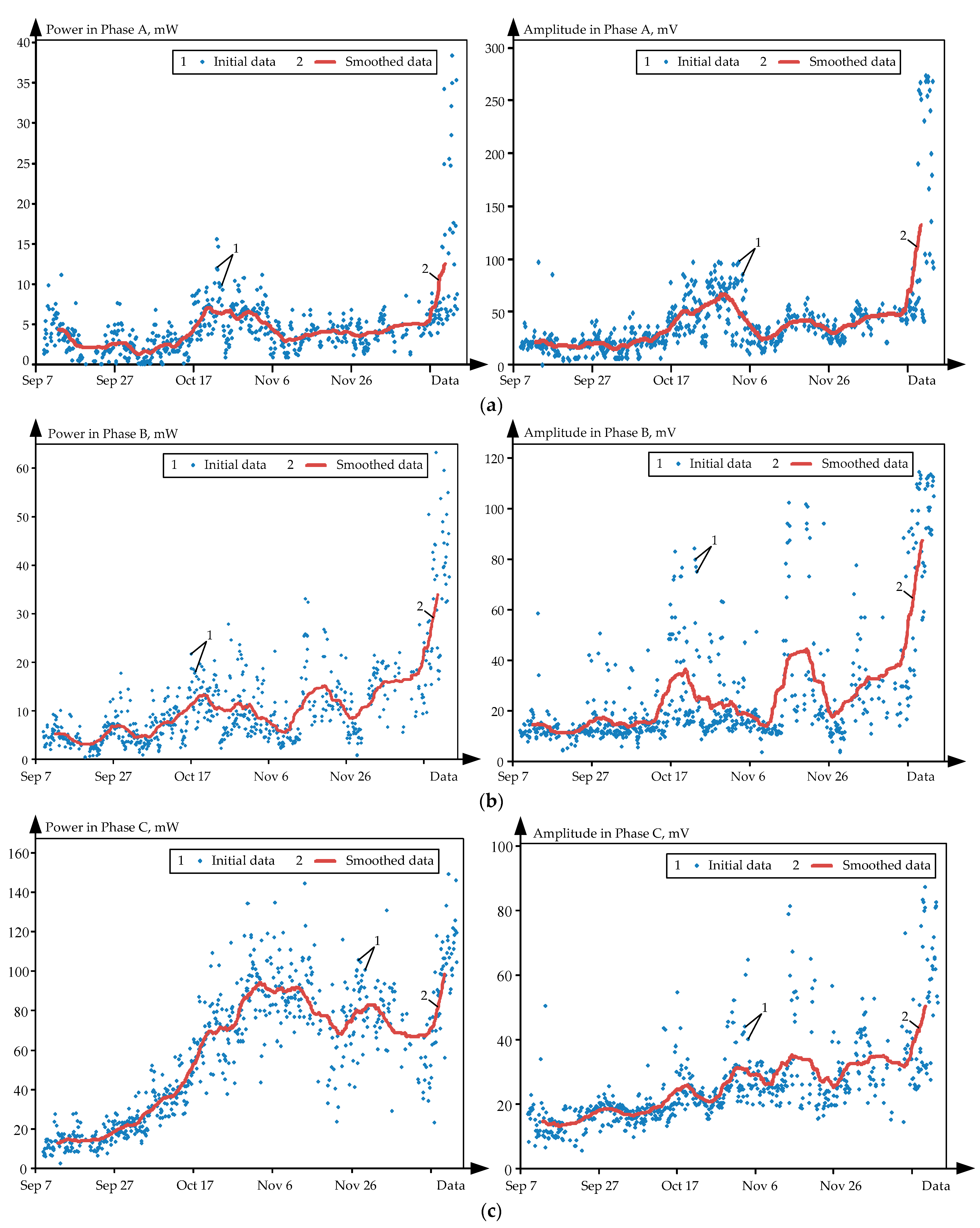

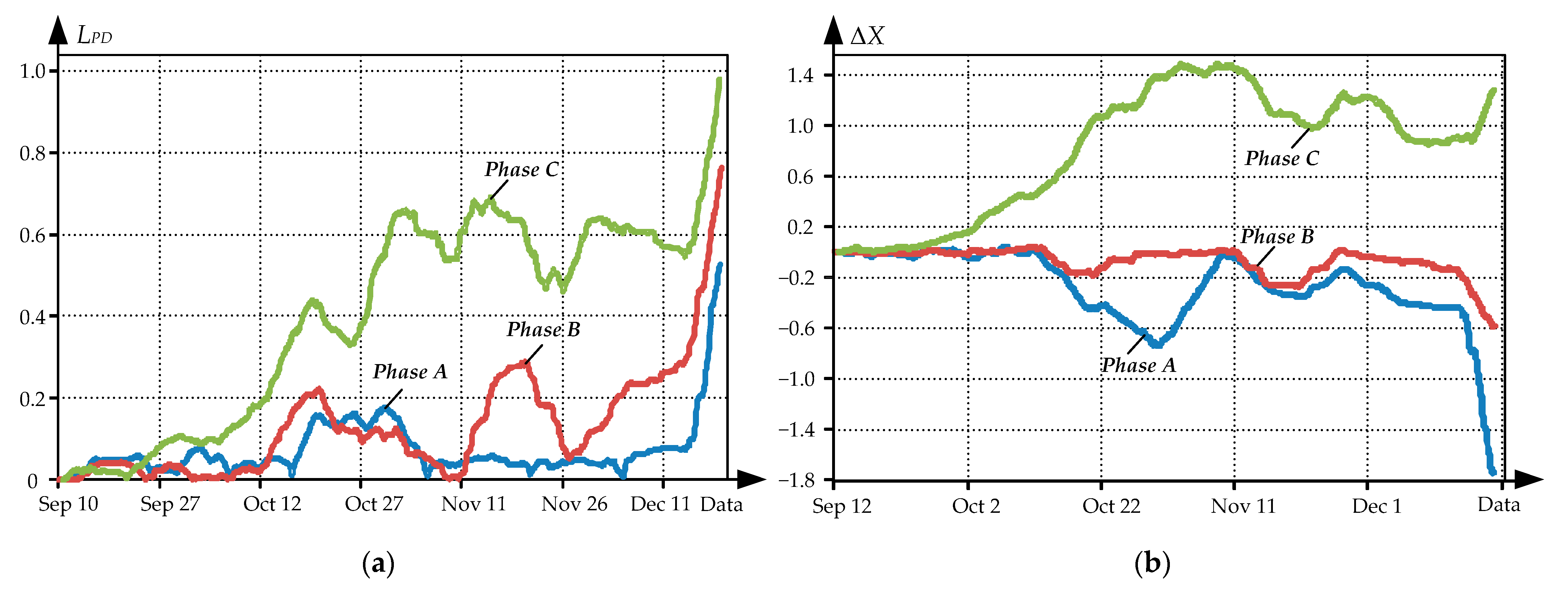

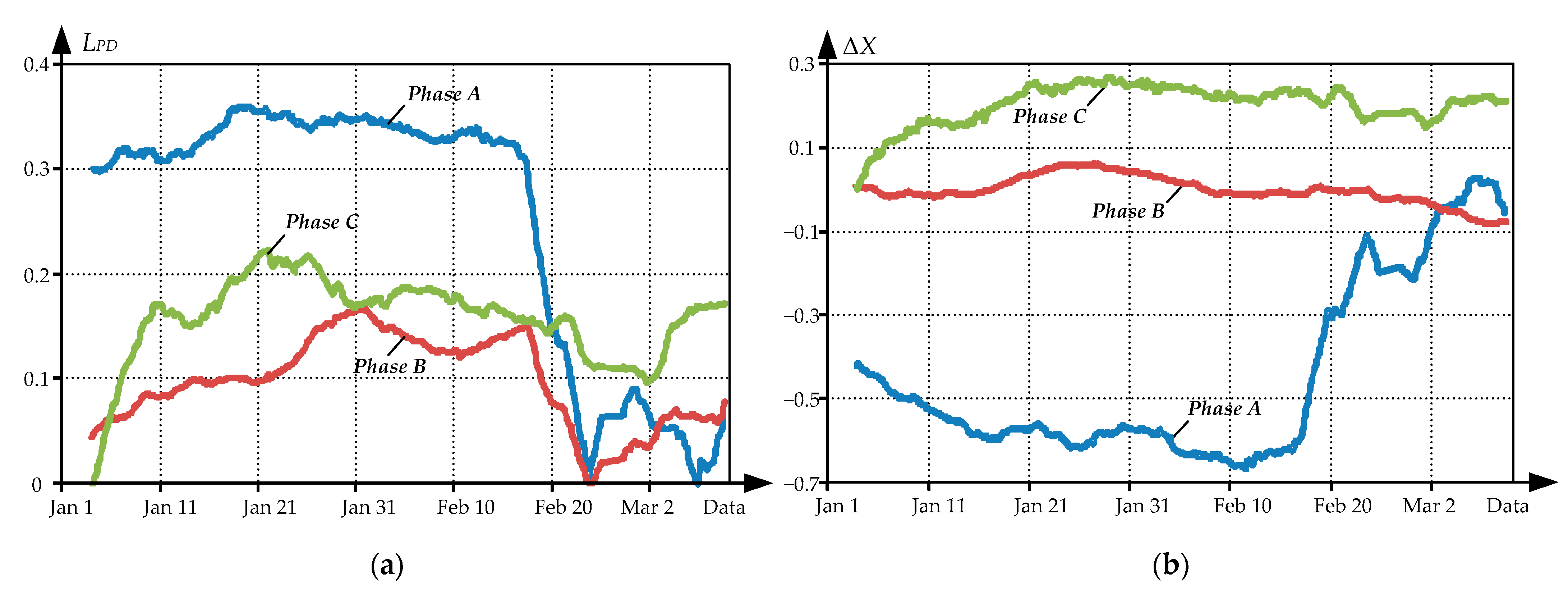
| Type | Rated Capacity, kVA | Rated Coil Voltage, V | Diagram and Group of Coil Connection | Number of OLTC Positions | Cooling System | Mass, Tons | Length × Width × Height, mm |
|---|---|---|---|---|---|---|---|
| ETTsNKV-40000/110-UHL-4 | 26,000–20,282 | 110,000 HV 421–289.5 LV | Υ/Δ-11 | 9 | Suspended“OFWF” | 80 | 4840 × 3540 × 6200 |
| Insulation Condition | Maximum Amplitude of Apparent Discharge, pC | Recurrence Rate, Pulses/s | PD Power, MW |
|---|---|---|---|
| Dry, clear–concentration of impurities < 50 particles/mL | <30 | 25–30 | <0.2 |
| Relatively clear–after repair with insulation flushing | 250–380 | 120–150 | 0.5–0.9 |
| Contaminated with hard impurities | 300–400 | 120–150 | 50–90 |
| Wet, heavily polluted with impurities | 220–400 | 1000–1800 | 470–800 |
| Classification According to [67] | Classification of Condition | Defect Evolution in Compliance with RD EO-0069-97 RU | Values of Maximum Amplitudes of Partial Discharges, C | ||
|---|---|---|---|---|---|
| In Windings and between Coils | Main Insulation, Barriers, According to RD cl.4.9.4 | Inputs According to RD cl.4.9.4 | |||
| Failed condition | PRE-EMERGENCY | Limit condition | Over 5 nC | Over 100 nC | Over 10 nC |
| IMPAIRED | Fatal defect | Up to 2.5 nC | 5–25 nC | 0.5–2.5 nC | |
| NORM with significant deviations | Major defect | Up to 500 pC | 1–5 nC | Up to 500 pC | |
| Operative condition | NORM with deviations | Minor defect | Up to 100 pC | Up to 1000 pC | Up to 100 pC |
| NORM | No evident defects | - | Up to 100 pC | - | |
| Linguistic Variable Type | Name | of the Term Set |
|---|---|---|
| Input | PD amplitude (U02) | Low |
| Medium | ||
| High | ||
| PD power (PDI) | Low | |
| Medium | ||
| High | ||
| Output | Insulation condition ISIPD) | Normal |
| Poor | ||
| Critical |
| Maximum PD Amplitude (U02) | PD Power (PDI) | ||
|---|---|---|---|
| Low | Medium | High | |
| Low | Normal | Poor | Critical |
| Medium | Poor | Poor | Critical |
| High | Critical | Critical | Critical |
| Name | of the Term Set | Membership Function Type | Values of the Membership Function Parameters |
|---|---|---|---|
| Maximum PD amplitude | Low | Gaussian | [x; 30; 0] |
| Medium | Gaussian | [x; 30; U1D] | |
| High | Two-sided Gaussian | [x; 30; U2D; 3, 4; 1, 25∙U2D] | |
| PD power | Low | Gaussian | [x; 20; 0] |
| Medium | Gaussian | [x; 10; P1D] | |
| High | Two-sided Gaussian | [x; 6, 8; P2D; 3, 4; 1, 25∙P2D] | |
| Insulation condition | Normal | Triangular | [−4; 0; 4] |
| Poor | Triangular | [1; 5; 9] | |
| Critical | Triangular | [6; 10; 14] |
Publisher’s Note: MDPI stays neutral with regard to jurisdictional claims in published maps and institutional affiliations. |
© 2022 by the authors. Licensee MDPI, Basel, Switzerland. This article is an open access article distributed under the terms and conditions of the Creative Commons Attribution (CC BY) license (https://creativecommons.org/licenses/by/4.0/).
Share and Cite
Karandaev, A.S.; Yachikov, I.M.; Radionov, A.A.; Liubimov, I.V.; Druzhinin, N.N.; Khramshina, E.A. Fuzzy Algorithms for Diagnosis of Furnace Transformer Insulation Condition. Energies 2022, 15, 3519. https://doi.org/10.3390/en15103519
Karandaev AS, Yachikov IM, Radionov AA, Liubimov IV, Druzhinin NN, Khramshina EA. Fuzzy Algorithms for Diagnosis of Furnace Transformer Insulation Condition. Energies. 2022; 15(10):3519. https://doi.org/10.3390/en15103519
Chicago/Turabian StyleKarandaev, Alexander S., Igor M. Yachikov, Andrey A. Radionov, Ivan V. Liubimov, Nikolay N. Druzhinin, and Ekaterina A. Khramshina. 2022. "Fuzzy Algorithms for Diagnosis of Furnace Transformer Insulation Condition" Energies 15, no. 10: 3519. https://doi.org/10.3390/en15103519






